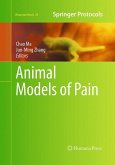With the loss of work days, the price of health care and payments for compensation, litigation, and malpractice, and the overwhelming cost of human suffering, chronic pain syndromes affect humanity enormously on both an economic and personal level. In Animal Models of Pain, expert investigators in the field provide a consolidated review of the current state of pain research by capturing the diversity of animal models that are used to investigate pain mechanisms, which range from surgical incision to mechanical compression and from spinal cord injury to cutaneous/local inflammation and beyond. As a volume in the respected Neuromethods series, this book delivers its vital content through detailed descriptions of a wide variety of step-by-step laboratory methods.Authoritative and cutting-edge, Animal Models of Pain seeks to lead scientists closer to the ultimate goal of improving the quality of life and relieving the unbearable burden of chronic pain for millions of people throughout the world.
From the reviews:
"This volume specifically covers animal models used to study different types of pain. ... The book has a very specific audience -- neuroscientists studying pain physiology and investigators trying to develop new pharmacological interventions for pain. It also may help clinicians to develop a better understanding of the testing methods used to develop new drugs as in relationship to their efficacies. ... It covers topics that are the backbone of the understanding and management of pain." (Tariq M. Malik, Doody's Book Reviews, March, 2012)
"This book critically describes the recent attempts to more directly model prevalent clinical pain syndromes to increase face and predictive validity of pain modelling tools. The book encompasses a total of 11 chapters, each written by authoritative researchers in the field. ... Each chapter describes in detail how the models in question are developed. ... appeal to scientists interested in understanding pain mechanisms and in the preclinical development of new analgesics, as well as clinicians aiming at advancing translation pain research." (Debby Van Dam, Clinical Neurology and Neurosurgery, January, 2011)
"This volume specifically covers animal models used to study different types of pain. ... The book has a very specific audience -- neuroscientists studying pain physiology and investigators trying to develop new pharmacological interventions for pain. It also may help clinicians to develop a better understanding of the testing methods used to develop new drugs as in relationship to their efficacies. ... It covers topics that are the backbone of the understanding and management of pain." (Tariq M. Malik, Doody's Book Reviews, March, 2012)
"This book critically describes the recent attempts to more directly model prevalent clinical pain syndromes to increase face and predictive validity of pain modelling tools. The book encompasses a total of 11 chapters, each written by authoritative researchers in the field. ... Each chapter describes in detail how the models in question are developed. ... appeal to scientists interested in understanding pain mechanisms and in the preclinical development of new analgesics, as well as clinicians aiming at advancing translation pain research." (Debby Van Dam, Clinical Neurology and Neurosurgery, January, 2011)








